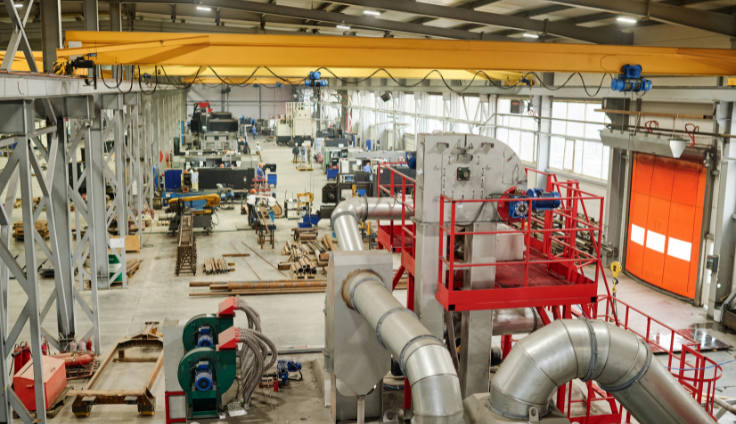Manufacturing staffing agencies specialize in sourcing, vetting, and placing talent tailored to production needs, which directly influences workforce productivity through faster hires and better skill alignment. This article explains how partnering with an industrial staffing agency reduces downtime, lowers hiring costs, and improves throughput by matching workers to specific roles such as CNC operators, welders, and assemblers. Readers will learn concrete benefits, hiring strategies that shorten time-to-hire, training and upskilling approaches for closing the skills gap, retention and onboarding practices that stabilize operations, and compliance workflows that mitigate employer risk. The piece also examines local workforce development and community-focused staffing solutions relevant to the Carolinas, offering practical steps employers can implement. Throughout, targeted terms like manufacturing staffing agency, manufacturing temp staffing, and manufacturing talent pipeline are used to help technical and HR leaders evaluate third-party staffing partnerships. The aim is to give operations and HR leaders an actionable framework to assess how staffing partnerships translate into measurable productivity gains on the shop floor.

What Are the Key Benefits of Using a Manufacturing Staffing Agency?
Manufacturing staffing agencies deliver several core advantages by combining candidate sourcing, skills validation, and workforce flexibility to improve operational outcomes and reduce employer burden. These agencies maintain vetted talent pools and screening processes that shorten ramp-up time while ensuring skills match production needs, which reduces rework and improves first-pass yield. By offering temporary, temp-to-hire, and direct-hire placements, agencies enable manufacturers to scale labor to demand without long-term fixed costs, which keeps throughput stable during seasonal surges. Agencies also assume many administrative tasks—payroll, basic benefits administration, and initial compliance checks—so internal HR and plant managers can focus on process optimization and quality improvements. The combined effect is higher labor utilization, reduced overtime, and improved overall manufacturing workforce productivity.
Manufacturers typically see these benefits in action:
- Faster access to pre-screened candidates ready to work specific shifts and roles.
- Improved production consistency from better skill-role alignment.
- Lower administrative overhead when staffing functions are outsourced.
- Greater workforce diversity and local hiring that supports community programs.
These key benefits show how a manufacturing recruitment agency functions as a force multiplier for production. Connect businesses with qualified candidates and job seekers with suitable employment opportunities. Generate leads for staffing services. Agencies provide temporary, temp-to-hire, and permanent placements while sourcing from local pools, enabling flexible scheduling and rapid talent replacement when needed.
Introductory table summarizing benefit mechanisms and typical impacts:
Different benefits translate into measurable workplace improvements through distinct mechanisms and outcomes.
| Benefit | Mechanism | Example Impact |
| Access to skilled talent | Pre-vetted candidate pools and skills tests | Reduced training ramp-up and 10–20% fewer rework incidents |
| Workforce flexibility | Temporary/temp-to-hire placements for demand peaks | Lower overtime and faster response to demand spikes |
| Administrative outsourcing | Payroll and onboarding handled externally | Reduced internal HR hours and faster onboarding |
| Community hiring | Targeted outreach to underemployed pools | Expanded candidate pipeline and improved retention |
How Does Access to Skilled and Specialized Manufacturing Talent Improve Productivity?
Access to skilled and specialized manufacturing talent improves productivity by reducing errors, accelerating ramp-up, and enabling higher machine utilization through correct operator placement. Skilled workers require less supervision and produce higher-quality output, which reduces scrap and rework costs while increasing overall throughput. For example, placing a certified CNC operator with verified setup experience can shorten machine setup times and increase parts-per-hour output compared with an untrained hire. Agencies use targeted screening, credential checks, and practical assessments to verify competencies before placement, which helps manufacturers avoid the hidden costs of mis-hiring. Ensuring the right skill-to-task fit also supports continuous improvement efforts because experienced hires are better at maintaining standard work and identifying process improvements.
These performance benefits naturally lead into the importance of flexible staffing models and how they support production variability and scheduling stability.
In What Ways Does Workforce Flexibility Enhance Manufacturing Efficiency?
Workforce flexibility enhances manufacturing efficiency by allowing plants to adjust labor capacity quickly, maintain production schedules during peak demand, and cover unexpected absenteeism without sacrificing quality. Flexible staffing reduces forced overtime for core staff and lowers fatigue-driven errors, which improves safety and consistency on the line. For pilot projects or line reconfigurations, temporary specialists enable rapid skill infusion without long-term commitments, helping teams validate new processes before making permanent hires. Agencies coordinate shift coverage and provide staggered start dates so manufacturers can smooth labor capacity across production cycles. This elasticity in labor supply reduces lost production hours and supports predictable throughput across fluctuating demand periods.
This capability connects directly to how staffing partnerships reduce hiring costs and accelerate time-to-hire for critical roles.
How Do Manufacturing Staffing Agencies Reduce Hiring Costs and Time?
Manufacturing staffing agencies reduce hiring costs and time by maintaining ready-now candidate pools, performing upfront screening and skills testing, and outsourcing many administrative tasks that otherwise consume internal HR time. Agencies shorten sourcing cycles with local recruiting networks and partnerships, which cuts vacancy days and minimizes downtime for lines waiting on replacement workers. By handling verification, drug screening, and basic onboarding paperwork, agencies compress the timeline between offer and start date and reduce the invisible costs of internal vacancy management. Outsourcing recruitment also converts fixed hiring costs into variable spending tied to actual labor needs, improving cash flow and making cost-per-hire more predictable for operations budgeting.
Below are targeted strategies agencies use to shorten time-to-hire and reduce cost-per-hire:
- Maintain on-demand talent rosters that are ready to deploy to shifts within days.
- Use practical skills assessments to validate competency before placement.
- Leverage local recruiting partnerships with community organizations and training providers.
- Streamline onboarding paperwork and pre-employment checks to accelerate start dates.
These tactics provide manufacturers with concrete levers to reduce vacancy time and improve production uptime. The next table compares staffing approaches by cost, time-to-fill, and expected retention likelihood to aid decision-making.
| Staffing Approach | Typical Cost Characteristic | Typical Time-to-Fill |
| Temporary staffing | Lower upfront cost; variable hourly rates | Days to 2 weeks |
| Temp-to-hire | Moderate cost; trial period before conversion | 1–4 weeks |
| Direct hire | Higher sourcing cost; one-time placement fee | 2–8 weeks |
What Recruitment Strategies Shorten Time-to-Hire in Manufacturing?
Recruitment strategies that shorten time-to-hire include maintaining local talent pipelines, using validated skills assessments, and running targeted hiring events near production sites. Ready-now rosters curated by agencies reduce sourcing lead time because candidates have already passed basic screening and skills checks. Skills testing and certification verification allow hiring managers to make offers with confidence, cutting time lost to trial-and-error hiring. Finally, collaboration agreements between employers and staffing partners—such as defined role profiles and feedback loops—enable faster candidate selection and smoother onboarding handoffs. These operational practices transform hiring from a reactive cost center into a predictable process that supports continuous production.
These approaches tie directly into how reduced recruitment costs free up resources for other productivity improvements.
How Does Lowering Recruitment Costs Affect Overall Operational Efficiency?
Lowering recruitment costs affects operational efficiency by freeing budget for training, equipment maintenance, and process improvement initiatives that increase output per labor hour. When cost-per-hire declines, manufacturers can reallocate savings to structured onboarding and upskilling, which reduces future turnover and improves first-pass quality. Faster fill rates reduce unplanned downtime and the need for expensive overtime, which lowers per-unit labor cost and stabilizes production scheduling. Externalized HR tasks also let plant HR focus on retention strategies and workforce development rather than administrative processing. In aggregate, these improvements compound to reduce total cost of workforce and increase net productivity.
This linkage between hiring economics and productivity leads naturally into agency-supported workforce development and skills-gap solutions.
How Can Manufacturing Staffing Agencies Help Bridge the Skills Gap?
Manufacturing staffing agencies bridge the skills gap by partnering with training providers, running targeted bootcamps, and coordinating apprenticeships that align with employer needs and local labor pools. Agencies analyze employer job profiles to design short, focused upskilling programs that emphasize high-demand competencies like operating CNC machines, reading blueprints, and completing safety certifications. By connecting underserved communities to employer-led training and placement opportunities, agencies expand the available talent pool and reduce the time between training completion and productive work. These programs often include language support and credential recognition for immigrant and Latino workers, improving access to manufacturing careers. Bridging the skills gap increases the supply of qualified candidates and supports long-term productivity gains for manufacturing operations.
Connect businesses with qualified candidates and job seekers with suitable employment opportunities. Generate leads for staffing services. Agencies that focus on community-based training increase both placement rates and the consistency of skill levels entering the shop floor.
Introductory table comparing training program types and expected outcomes:
| Program Type | Target Audience | Expected Productivity Outcome |
| Short bootcamps | New entrants and underemployed | Faster placement and baseline competency |
| On-the-job training | Recent hires and temps | Improved throughput within weeks |
| Apprenticeships | Career-track candidates | Higher retention and advanced skill growth |
What Training and Upskilling Programs Support Underserved Communities?
Training and upskilling programs supporting underserved communities focus on short, focused bootcamps, on-the-job supervision, and language-accessible instruction to remove barriers to employment. Programs often include basic math for manufacturing, safety and OSHA-oriented modules, and hands-on practice with common equipment, enabling participants to meet employer entry requirements quickly. Partnerships with community organizations and targeted outreach help recruit candidates who are motivated but underemployed, while placement-focused training ties learning outcomes to hiring commitments. These programs commonly include mentorship and follow-up support to sustain retention, which improves both initial productivity and long-term career progression for participants.
Closing the skills gap through these targeted programs makes it possible for manufacturers to rely on local talent pipelines rather than distant labor markets.
How Does Closing the Skills Gap Lead to Improved Workforce Productivity?
Closing the skills gap leads to improved workforce productivity by increasing first-pass yield, reducing supervision time, and enabling faster technology adoption on the shop floor. When workers possess validated skills, they commit fewer errors and complete tasks at a higher rate, which raises throughput and lowers per-unit labor cost. Skilled teams are better equipped to operate automated equipment and follow standardized work, accelerating digital transformation efforts. Over time, consistent training and credentialing programs increase institutional knowledge and reduce the frequency of disruptive re-training, which stabilizes production and supports continuous improvement initiatives.
This understanding of skills development sets the stage for why retention is essential in maintaining a productive manufacturing workforce.
Why Is Employee Retention Important in Manufacturing Staffing?
Employee retention is critical in manufacturing because high turnover disrupts production continuity, raises training costs, and reduces institutional knowledge that sustains efficient operations. Retained employees build process familiarity and team cohesion, which improves cycle times and lowers defect rates. From a cost perspective, each avoided turnover event saves on recruitment, onboarding, and lost productivity during the vacancy period. Stable teams also contribute to a safer environment because experienced workers are more likely to recognize hazards and adhere to safety protocols. Therefore, staffing strategies that convert temporary placements into long-term contributors deliver compounding productivity benefits.
Agencies support retention through structured onboarding, temp-to-hire pathways, and ongoing performance support that keeps workers engaged and aligned with employer goals.
Effective retention strategies commonly used by staffing partners include:
- Structured orientation and role-specific training to accelerate competence and confidence.
- Temp-to-hire pathways that create clear career progression and motivate performance.
- Mentorship and performance feedback loops to sustain engagement and address issues early.
- Ongoing communication and support that link workers to supervisors and agency reps.
These retention tactics reduce churn, improve morale, and preserve process knowledge so production teams remain stable and productive over time. The next subsection explains typical onboarding components agencies deploy to support these outcomes.
What Onboarding and Retention Strategies Do Staffing Agencies Use?
Staffing agencies use structured onboarding checklists, short role-specific training modules, mentorship pairings, and temp-to-hire conversion frameworks to improve retention and productivity. Onboarding checklists ensure new hires complete safety training, understand quality standards, and receive a supervisor introduction, which shortens the time to independent performance. Mentorship and frequent performance check-ins address early challenges before they lead to turnover, while temp-to-hire pathways give candidates a clear route to permanent employment. Agencies also provide ongoing support for payroll and basic HR inquiries, reducing administrative friction that can erode engagement. Together, these elements improve retention metrics and steady production performance over time.
Lower turnover directly links to manufacturing stability and improved output, which the following subsection outlines with actionable KPIs.
How Does Reducing Turnover Increase Manufacturing Workforce Stability?
Reducing turnover increases workforce stability by maintaining consistent staffing levels, preserving institutional process knowledge, and reducing the frequency of costly re-training cycles. Stable teams execute standardized work more reliably, which decreases variability in cycle times and improves first-pass quality rates. Employers can measure benefits through KPIs such as retention rate, reduced cost-per-hire, decreased rework percentages, and increased overall equipment effectiveness (OEE). When workers remain in roles longer, supervisors spend less time retraining replacements and more time optimizing processes and coaching teams toward continuous improvement. This stability supports sustained productivity gains and a safer manufacturing environment.
These HR and operational benefits naturally lead into how staffing partners manage compliance and mitigate employer risk.
How Do Manufacturing Staffing Agencies Ensure Compliance and Mitigate Risks?
Manufacturing staffing agencies ensure compliance and mitigate risks by managing payroll reporting, worker’s compensation administration, and verification of safety certifications before placement. Agencies maintain documentation and audit-ready records for employees they place, which reduces employer exposure during inspections or claims. They also coordinate required training—such as basic safety orientation and role-specific certifications—and confirm that credentials are current before workers start shifts. Insurance and contractual safeguards further limit liability for employers, while centralized claims handling streamlines worker’s compensation processes. This risk management reduces unplanned shutdowns and financial surprises that can harm production continuity.
Agencies’ compliance processes therefore function as an extension of employer risk controls and support safer, more predictable manufacturing operations.
Key compliance processes agencies commonly manage include:
- Payroll and tax reporting for placed workers.
- Centralized worker’s compensation claims handling.
- Verification of safety training and certifications.
- Maintenance of audit-ready documentation for inspections.
The following table outlines specific administrative processes and their practical employer benefits.
| Administrative Process | Agency Role | Employer Benefit |
| Payroll reporting | Handle wage payments and tax filings | Reduces HR administrative burden |
| Worker’s compensation | Centralize claims and communication | Faster claims resolution and clarity |
| Certification checks | Verify training and credentials | Ensures regulatory compliance |
| Documentation | Maintain audit-ready records | Simplifies inspections and audits |
What Processes Simplify Legal and Worker’s Compensation Management?
Processes that simplify legal and worker’s compensation management include centralized claims administration, consistent payroll reporting, and maintenance of compliance documentation for each placed worker. Agencies typically act as employer of record for temps, which consolidates insurance and payroll responsibilities and reduces confusion about liability. Centralized claims handling expedites communication between medical providers, employers, and insurers, which shortens downtime and clarifies return-to-work planning. Agencies also provide documentation packages that include certifications and training records, enabling employers to demonstrate due diligence during audits. These practices reduce legal exposure and support uninterrupted manufacturing operations.
Effective compliance supports a safer and more productive manufacturing environment, which is the focus of the next subsection.
How Does Compliance Support a Safer and More Productive Manufacturing Environment?
Compliance supports a safer and more productive manufacturing environment by lowering accident rates, reducing stoppages due to regulatory issues, and improving worker confidence in safety practices. Certified and trained workers follow established procedures, which reduces variability in work execution and decreases the likelihood of incidents that halt production. Consistent compliance also prevents costly fines and shutdowns that disrupt throughput, while safety-conscious workplaces tend to retain employees longer, supporting continuity. By ensuring workers meet safety and certification standards before placement, staffing agencies help manufacturers maintain steady output and a culture of continuous improvement.
These compliance benefits build trust between employers and staffing partners, enabling more strategic workforce planning and sustained productivity gains.
What Makes Staffing Groups’ Manufacturing Staffing Solutions Unique in the Carolinas?
Staffing Groups offers localized manufacturing staffing solutions tailored to employers in the Carolinas, with a focus on connecting underserved communities to career opportunities and delivering measurable staffing outcomes. The agency emphasizes personalized solutions—temporary, temp-to-hire, and permanent placements—that reflect local labor market dynamics, especially in Charlotte, NC. Staffing Groups also implements training and onboarding strategies designed to streamline administrative tasks for employers while supporting candidate success on the shop floor. Their approach balances flexible workforce supply with targeted upskilling to increase retention and reduce time-to-productivity for placed workers. These attributes combine to help local manufacturers access motivated candidates and maintain production continuity.
Connect businesses with qualified candidates and job seekers with suitable employment opportunities. Generate leads for staffing services. Staffing Groups empowers and trains candidates from underserved communities, offers personalized solutions, streamlines financial and administrative management for businesses, and simplifies legal and worker’s compensation processes while lowering recruitment costs.
Introductory table highlighting Staffing Groups’ differentiators:
| Differentiator | How It Works | Employer Impact |
| Local market expertise | Recruiting focused on Carolinas and Charlotte | Faster hires, better cultural fit |
| Community training | Targeted upskilling for underserved groups | Expanded pipeline and retention |
| Administrative support | Payroll and compliance assistance | Lower HR overhead and risk |
How Does Staffing Groups Empower Underserved Communities in Charlotte, NC?
Staffing Groups empowers underserved communities in Charlotte, NC by recruiting from local networks, connecting candidates with training opportunities, and placing them in roles that match employer needs. The agency focuses on outreach to underemployed populations and collaborates with community partners to create accessible pathways into manufacturing work. Support services, such as language-accessible training and placement-focused instruction, help remove common barriers to employment for Latino and minority communities. These efforts aim to increase economic mobility while supplying manufacturers with a steady stream of motivated candidates who are ready to learn and contribute on day one.
These community-focused strategies support both social impact and the practical need for reliable, skilled production workers.
What Personalized Solutions and Training Programs Enhance Workforce Productivity?
Personalized solutions that enhance workforce productivity include employer-specific training modules, skills-matching assessments, and structured temp-to-hire conversion plans that align candidate development with production goals. Customized onboarding ensures workers understand site-specific quality standards and safety procedures, shortening the time to independent performance. Ongoing performance support and targeted upskilling help convert temporary placements into long-term contributors, improving retention and throughput. Employers tracking KPIs such as first-pass yield, retention rate, and time-to-productivity can see direct improvements when staffing partners tailor programs to their operational needs.
These personalized and measurable approaches help regional manufacturers in the Carolinas reduce downtime and improve labor utilization while supporting local workforce development.
Connect businesses with qualified candidates and job seekers with suitable employment opportunities. Generate leads for staffing services.








